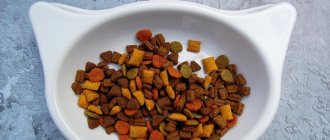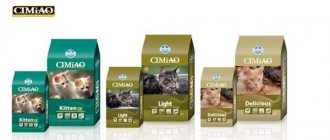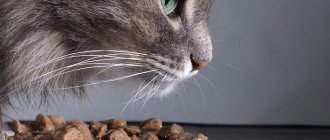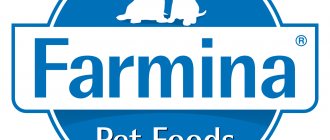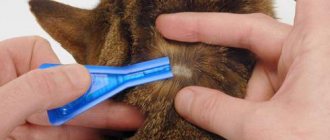The general hysteria around supposedly harmful dry food has led to the amazing but natural popularity of wet food. The most common logic of the majority is the most primitive: if I don’t feed my cat dry food, it means I’m feeding it correctly. Is it really? Nobody wants to think about it because it is a very comfortable position.
On the one hand, I don’t feed scary, incomprehensible dry food, which means I’m not baiting the cat (my conscience is clear), on the other hand, it’s convenient - I don’t need to prepare food for the cat. But in reality, everything is completely different. Wet food is no better than dry food - this is self-deception!
The history of cat food
The friendship between cats and humans began with mutually beneficial cooperation back in the 19th century. While stockpiling grain, people were faced with an invasion of rodents that spoiled the harvest and spread terrible infectious diseases, such as the plague.
The cats came on their own, from nowhere, significantly reducing the number of rats and mice. In gratitude for the help, people began to feed the animals, keep them in their homes, and care for them. The pets happily accepted the conditions.
By the mid-19th century, rusks for feeding dogs were invented. This inexpensive product saved time on preparing food for dogs and was easy to use. The innovation quickly spread, and pet food could be found in the basket of the average Englishman leaving the store.
The year 1930 was marked by the release of the first canned meat for cats. The animals appreciated the invention and happily switched to tasty and healthy diets.
Literally a few years later, the war began and all the metal used by people in everyday life was sent for the production of weapons. In reality, no one was going to give up such a profitable business as producing animal diets. By 1946, dry cat food packaged in regular paper bags was widely used.
Ease of use, low cost, long shelf life and balanced composition have made the product popular in a matter of years.
Advantages and disadvantages of dry food
Pelleted diets have their positive and negative sides and should be considered from the point of view of the individual characteristics of the animal. It often happens that a positive indicator for one animal turns into a negative one for another.
Pros:
- Pelleted diets have a long shelf life, not because they contain a lot of preservatives, but because they are completely dehydrated. Due to dehydration, mold bacteria and fungi do not have a food source and the product does not spoil. Crackers are convenient, you can take them with you on the road.
- Relatively low cost. Even if you buy the highest class food - holistic, it will not cost much. This is due to the fact that dried pieces contain much more nutritional components and are consumed less. Small dosages allow you to feed your pet for a long time, while the animal receives everything it needs, including minerals and vitamins.
- Cats love to carry food around the house. By removing pieces of food from the bowl, they do not stain the floor or carpets. The dryer is easy to clean and does not leave greasy marks.
- During meals, dense granules cleanse your pet's teeth of plaque, which over time turns into stone and can cause disease.
Minuses:
- Dehydrated foods do not contain the moisture that your cat needs. If, while eating dry food, the animal consumes little water, various kidney pathologies may develop. Therefore, it is important to ensure that your pet drinks as much as possible.
- It is important to observe the dosage of food with particular strictness. High concentrations of nutrients in low volumes can lead to overfeeding and obesity, especially in neutered animals.
- Pelleted diets place increased stress on the salivary and gastric glands as more fluid is required for digestion.
- Excessively dense products can, instead of gently cleaning teeth, destroy enamel. Therefore, when buying a diet, you should try to cut it with a knife; it should not be too dense and easily break into pieces under pressure.
- Heat treatment is used to dehydrate dry food, so a lot of the useful stuff is lost. There are alternative technologies that allow you to preserve everything you need for a healthy diet, but they are expensive. Therefore, economy class feed producers cannot afford such investments. These foods should be avoided.
Rules for feeding dogs food
And yet, what to choose: canned food or dry dog food? Or maybe semi-moist? How to choose food for your pet? Focus on your pet, observe whether he eats food with appetite or stands over the bowl for a long time. It is also worth consulting with a veterinarian when choosing the type of food. But, as mentioned above, according to the standards for feeding dogs with dry food, the diet should be diluted with canned food and even natural food.
Mixing different types of food is strictly prohibited. But you can give them one by one. For example, give granules in the morning, and in the evening pamper your pet with wet food. And do not forget that when eating dry food, the animal drinks a lot of liquid. How to transfer an animal from one type of food to another or introduce a new type of food into the diet? Keep in mind, this is a long process, not a one-day process. Gradually give your pet a new type of food, increasing the portion over 7 to 21 days.
Experts advise feeding your dog 1-2 times a day (depending on the breed and size of the pet). Give food at the same time in a certain amount. It is undesirable for food to be freely available: a pet may eat not because of hunger, but to satisfy its taste buds.
Advantages and disadvantages of wet food
Animals like wet diets more - this is an immutable truth, tested by many breeders. The consistency of such food is closer to the natural diet and, due to the presence of moisture in it, it has a brighter aroma.
Pros:
- A wet diet contains a lot of protein and fats, which are necessary for the animal's health and beautiful coat.
- Each product package contains up to 75% of the moisture a cat needs for healthy digestion.
- Allows you to eliminate overeating as a result of being saturated with protein and quickly induces a feeling of fullness.
- Pets like the aroma and taste of wet food; they eat the offered portion with appetite, regardless of their mood and health status. Canned food is recommended for those animals that eat little and reluctantly.
Minuses:
- The product is more expensive and not as economical as granular.
- It is not sold in large quantities, as it quickly deteriorates when opened.
- Causes an unpleasant odor from the animal’s mouth as a result of the formation of bacterial plaque, and with constant use it provokes diseases of the teeth and gums.
Cook your own food
Food prepared independently in your own kitchen from store-bought products seems to many cat owners to be preferable to feeding ready-made industrial diets. Indeed, you make up your own diet, you know exactly what ingredients you used, and you can vary them among themselves. However, not all owners are thoroughly familiar with veterinary nutrition, and certainly no one has a laboratory at home to check the chemical composition of food to ensure it contains all the substances cats need.
In nature, these animals hunt and receive a set lunch every day, eating the entire carcass of a mouse or bird almost entirely. It is simply impossible to provide them with such nutrition by buying food in a store, since people do not eat this, and accordingly, meat is not sold to them in this form. And one fillet and selected offal is clearly not enough to provide the cat with all the substances it needs.
Therefore, when feeding naturally, it is imperative to use vitamin-mineral complexes on an ongoing basis, which, firstly, is expensive, secondly, troublesome (not every cat is happy to eat tablets, even if they are not bitter), and thirdly, main ones - not always effective.
Mr. Cat recommends: selection options
The choice of diet consistency does not affect the health of the animal in any way - this is a proven fact. The main factors of proper nutrition are the individual characteristics of the cat.
When considering product parameters, we always take into account the physiological characteristics of the animal, its habits and preferences.
Water content
Moisture in the diet is essential for a cat; it promotes digestion and helps the proper functioning of the genitourinary system. Animals that consume little water need wet food; canned food and spiders are optimal for them. Those pets who drink enough fresh liquid can eat kibble and wet food.
Completeness and balance
When considering the concentration of nutrients in a product, it is important to take into account the condition of the pet; the balance should be different for each animal. For example, a pregnant cat needs more fat and calories, while a sterilized cat needs to choose a dietary product. Kittens need special types of food that replace mother's milk, create an immune system, and prepare the baby's stomach for adult food. The concentration of vitamins and minerals also varies, therefore, when choosing a diet, the physiology and age of the animal are taken into account.
Dental condition
An important aspect of choice. Dry products have a preventive effect, preventing the formation of tartar. Wet diets do not have this effect; they have the exact opposite effect, promoting the formation of bacteria in the animal’s mouth. Of course, if as a result of circumstances a cat has lost its teeth, it cannot be given dry food, but it is recommended to feed healthy animals with preventative foods.
Storage
When buying food for animals, look at the shelf life. This is as important as it is for people. Expired rations, even dry ones, negatively affect the health of the animal and can serve as a source of serious illness.
Wet food should not be kept open outside the refrigerator. Even at the required temperature, pates do not stand open for a long time; they are stored for no more than 1 day. This is why wet rations are sold in small quantities.
Dry foods last a long time, but not forever. An open pack without a zipper quickly absorbs moisture, allowing bacteria to grow. Therefore, it is recommended to keep the granules in tightly closed boxes, avoiding contact with water.
Price
The price of the diet speaks volumes about the quality. Cheap products may not contain healthy natural ingredients, but excessively inflated prices are not a sign of healthy nutrition. Let's consider this using the example of the famous Royal Canin brand, which has occupied the leading positions in the ratings for many years. Since the transfer of production rights to the Mars company, the quality of the food has greatly declined. This is noted by breeders and veterinarians, however, the cost of the diet has remained unchanged, despite the fact that the food has dropped a class lower and is no longer so popular.
When choosing a product for an animal, price and brand should not be the deciding factor. It is much more important to pay attention to the composition and reviews of breeders.
Which is better, dry or wet cat food?
Having considered above all the advantages and disadvantages of dry and wet products, having determined the selection criteria and having sorted out the price, we conclude that the diets are equivalent. It cannot be said that one type of food is better, they contain the same components, also cause allergies, are beneficial, but sometimes cause harm to some animals. All this is individual and cannot be generalized in any way.
To keep your pet healthy, it is recommended to avoid common mistakes that are common to all novice breeders. Let's look at them below.
Common Mistakes
The quality of rations of different consistencies differs - the main misconception of the owners. It is mistakenly believed that dry Whiskas food is harmful, but wet food is not. Products of the same brand are made from the same ingredients, the only difference being the amount of moisture and preservatives. Therefore, if a cat is allergic to kibble food, he will also react to wet food.
The pictures on the packaging do not match the contents. This marketing ploy is known to everyone, despite this, animal owners buy a pack without looking at it with a nice large piece of meat on the front of the package. It is worth paying attention to the back side, where the composition is written. The amount of protein is an important aspect for animals, but if its origin is unknown, then is it worth risking the pet’s health?
It is unlikely that any breeder would buy skin and internal fat for a cat; all these are by-products, which are written about in such a veiled manner on packs of economy-class food. When choosing food, they look for dehydrated meat; if it is contained in even a small percentage, it means that the pet will actually get the necessary protein. 30% or more is a sign of a product of the highest class - holistic feed. This does not mean that they will necessarily be expensive; often little-known brands are cheaper than advertised premium diets.
It is believed that cats refuse food of poor quality. This is the most common misconception. Animals are guided by their sense of smell, so by adding flavor enhancers and flavorings to food, the manufacturer will force the animal to eat anything. It is wrong to think that dry food, which makes cats turn up their nose, is bad; perhaps, on the contrary, they do not contain many additives. An example of this is the Akana brand, which is perhaps the best today. Many pets, especially those accustomed to Whiskas or Kitekat, often refuse this holistic treatment.
Some cat lovers think that including natural meat and dairy products in the diet of a cat eating dry food is beneficial. This is the most dangerous misconception for a pet. By mixing regular food and canned food, the owner upsets the balance that the animal needs so much for normal functioning. In addition, the cat may refuse water. It is also undesirable to use mixtures from different manufacturers. If you combine food, you should give preference to one brand and take dry and wet diets of the same brand.
The quality of ingredients is an indicator of which food is better
Many people believe that wet food is more “natural” than dry food, but this is a purely subjective opinion, not based on anything. It’s just that the contents of the jar seem more attractive and “edible” in appearance than dry granules, and manufacturers diligently maintain this impression in us by creating food that is shaped like pieces of meat in sauce or pate, that is, appetizing dishes from the human table.
However, if you look at the composition of the product, you will understand that these “pieces” and pates are made from the same mixture of different ingredients as dry food. So there is no fundamental difference between them.
Thus, if you want to decide which food is better, dry or wet, then pay attention not to the pictures on the packaging, beautiful names and shape of the product, but only to the list of ingredients. Both diets should be based on meat, which is what you should look for first on the list.
Undesirable components, again, in both feeds, are wheat, isolated vegetable protein, hydrolysates, as well as ingredients of unknown origin, indicated in general terms such as “meat and its processed products”, “cereals”, etc. Only a high-quality composition that meets all the needs of animals is a criterion in favor of a particular diet, and not at all its form.
Both cats and dogs can eat dry food throughout their lives without any harm to their health. A dehydrated diet is digested just as well as a wet diet, and except in rare cases, for example, during post-operative care for an animal, there is no indication for feeding your pet wet food.


